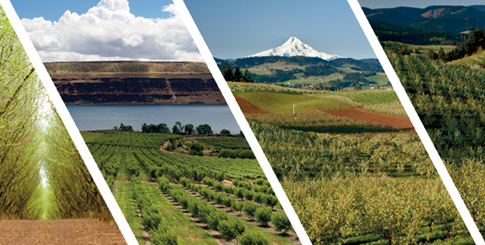Conventional & Organic
The Willamette River, flowing south from Portland, is the reason for Oregon’s outsized influence on so many crops. With mountains bordering three sides of the river’s valley, this unique geography creates ideal microclimates for both conventional and organic crops. The valley’s alluvial, volcanic soil and steady water supply also contribute to consistent, high-quality crops.
Chuck Botsford, president of Botsford & Goodfellow, Inc. in Portland, handles a wide variety of fruits and vegetables from asparagus and blackberries to garlic and rhubarb. “We ship a lot of rhubarb,” shares Botsford, to both U.S. and Western Canadian clients. “Radishes, rutabagas, turnips, parsnips, beets—all come from the Willamette Valley,” he says.
The Willamette Valley supplies similar organics as well. “Primarily, we do all the leafy row crop items west of the Casca-des,” explains Mike Neubeck, director of purchasing for Organically Grown Company, in Eugene. “Broccoli and root crops are big,” he says, and “there are some small organic apple deals up the Columbia River Gorge,” he adds.
Retailers & Consumers
Portland, Oregon’s largest city, is known as a foodie haven replete with fusion cuisine, progressive grocers and co-ops, trendy eateries, and health-conscious consumers. But shippers and receivers here say strong fresh produce demand is driven by something simple to quantify: sheer numbers. “I think we’ve seen demand/growth mainly due to the Oregon population growing,” says Botsford.
Retailers have jumped in to feed the masses. Costco, headquartered in Washing-ton state, has a huge presence; Walmart is in Portland, as is discounter Grocery Outlet. National chains in the heavily populated I-5 corridor include Albertsons/Safeway, Kroger’s Fred Meyer and QFC banners, WinCo, Whole Foods, and Trader Joe’s. East of the Cascades, Northwest Grocers has Thriftway and Select stores throughout the state.
Consolidation shifted the retailer landscape in western Oregon. “Safeway and Albertsons went from two distribution centers to one, two groups of buyers to one,” observes Botsford. Idaho-based WinCo, also operating under its Waremart banner, has opened more stores. “WinCo is a fairly young company, compared to the others; they’re growing here,” he adds.
Smaller, specialty grocers and food co-ops are plentiful in Portland, where multistore chains include Green Zebra Grocery, Zupan’s Markets, Natural Grocers, and New Seasons Market. Some of these chains extend a store or two to markets like Ashland, Bend, Corvallis, and Salem. Eugene is also a specialty grocer hotbed, with Market of Choice maintaining four locations.
Sourcing organics has become increasingly price-sensitive. “Pricing point consciousness has become more acute in the last year or two,” observes Neubeck. High produce volume makes surpluses and seconds inevitable, and Oregon produce grower-shippers are big supporters of foodbanks. “Recently, the Portland area foodbank got some funds to pay for freight, to return a little bit to growers for handling and getting product out,” says Neubeck.



